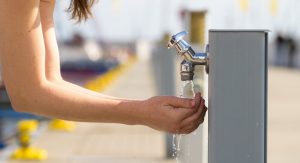
Definition of drinking water.
Water is not naturally potable. Potable water is water that humans can drink and use without risk. In its journey, water encounters substances that are harmful to the body, which is why water needs to undergo several treatments before it can be considered potable. Several potability criteria have been defined to protect against health risks.
Discover our associated services: Temporary drinking water, Temporary sanitation and Maintaining water potability.
Where does drinking water come from in France? In the world?
Water can come from various natural and surface sources. 62% of tap water comes from groundwater. The rest comes from streams, rivers and lakes. As it is collected through catchment in drilling sites or wells, water is first filtered naturally by the soil. This is what is known as the “small water cycle”.
To use water as a resource, humans have had to become part of its natural cycle and have organized a system split into five major steps:
- Water pumping: the water is collected from water tables or surface sources and arrives at the pumping station.
- Water treatment: The treatment plant passes the water through several filters to remove impurities.
- Water storage: Once potable, the water is stored in storage basins or reservoirs (such as water towers) or in underground reservoirs, as in Paris.
- Distribution of potable water: Water is supplied upon request via a piping system equipped with control valves and accessories.
- Wastewater treatment: After water is used by users it is brought to a treatment plant for cleaning before being discharged into the natural environment.
What are the criteria of water potability?
Diseases linked to water are the leading cause of death in the world. To be considered potable, water needs to cleansed of a certain number of substances that are harmful to health:
- Pathogenic germs: bacteria and viruses
- Parasitic microorganisms
- Chemical substances: nitrates, phosphates, heavy metals, hydrocarbons, pesticides.
Drinking water will keep some of its natural substances that are good for human health, such as mineral salts, calcium, magnesium and trace elements.
Currently there are 63 criteria for water potability grouped into five categories:
- Physico-chemical properties (pH, temperature, conductivity and hardness)
- Organoleptic properties (colour, taste and smell)
- Microbiological properties (pathogenic germs responsible for disease and epidemics)
- Properties linked to undesirable substances (nitrates, nitrites, pesticides)
- Properties linked to toxic substance (arsenic, cyanide, chromium, nickel, selenium, hydrocarbons)
How does potable water treatment work?
As explained before, the water drawn needs to undergo several treatments before being distributed. Nine steps are required for water to become potable:
- Catchment
- Screening
- Microstraining
- Settling
- Sand filtration
- Ozonation
- Filtration
- Chlorination
- Quality and sanitary inspections
In a temporary supply, the water’s potability must be just as irreproachable. Waterlab is committed to respecting the strictest standards: The water we supply in our pipes complies with potability standards. Our entire range of water fountains meets this need. To ensure this, we establish analysis at the connection or adduction point so we are certain all parameters are optimal and are able to obtain a certificate for use from a COFRAC accredited laboratory. The pipelines installed are then fully cleaned and disinfected. Thanks to an innovative system that is the only of its kind in the world, the water is treated continuously using a non-intrusive patented system that requires no chemical products.
Discover our other pages about drinking water: Temporary drinking water, Temporary sanitation and Maintaining water potability.